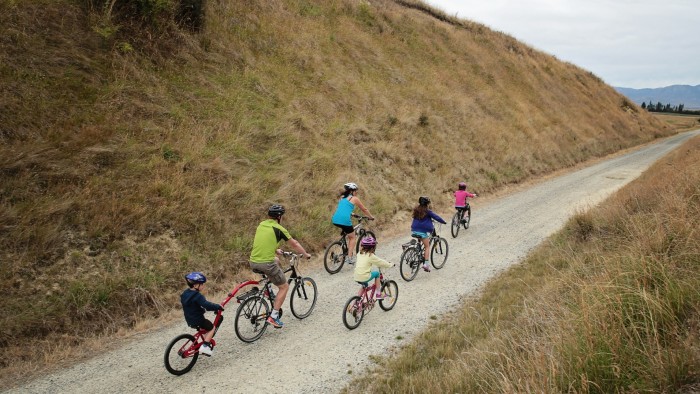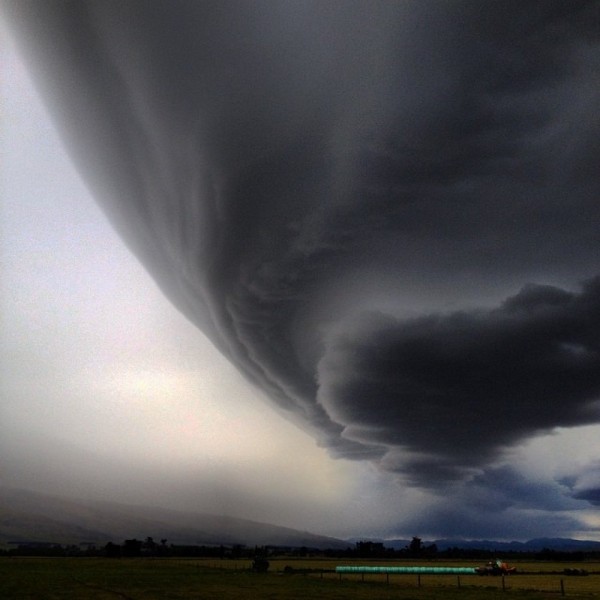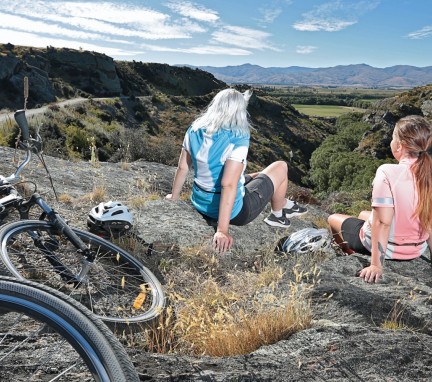The compacted gravel pathway is easy to cycle or walk on – as it was made for a train, there are no really steep hills and it is wide enough for cyclists to pass each other comfortably.

Track Width and Surface
The Trail is Grade 1 / Easy. The track is not sealed, but most of it is compacted and hard. Paths are 2-way, which means that you can be sociable and ride alongside a friend most of the time. There are some narrow cattle-stop grates, and “chicanes” (s-shaped safety gateways) before a road crossing, but the minimum width on all barriers is 900mm. This means that the track should be accessible to most wheelchairs and hand-bikes – though the chicanes will require some manoeuvrability to get around if you are towing a child trailer, etc. When there is a gate (e.g. the road crossing near Daisybank) it will not be locked, but needs to be closed behind you.
Gradient
As the track was originally built for a steam train, the gradient is an easy one. Overall the elevation climbs from 200 m – 618 m at Wedderburn (the highest peak of the Trail). Tiger Hill, between Chatto Creek and Omakau, may have some cyclists pushing their bikes for a short time, but the incline is only 1:50 (or a 2% rise in elevation). However, a tail wind or a head wind in any place can make a huge difference in the amount of effort required.
Dramatic Landscapes
Central Otago landscapes have been immortalised by artists – distant, tawny-toned hills, their flat tops perhaps iced with snow, startling white against a big, blue sky.
Some landscapes are unchanging. Following the streams that flow through the dry, rocky gorges near Alexandra, or near Daisybank in the Strath Taieri, is like being on a Wild West movie set. Other landscapes are transformed by the seasons – dry hills, covered for much of the year in drab, brownish plants, are suddenly painted mauve as wild thyme blooms in early summer. And tall viper's bugloss wildflowers create a purple haze as you follow the Manuherikia River near Chatto Creek. Then there are the spectacular autumn colours, the craggy rock formations… or the unique landscapes created by man – old stone buildings, viaducts and tunnels. Don’t forget your camera. And don’t forget to go outside and be amazed at that big night sky – no street light pollution here.
For many visitors, however, it is the sense of vast, open spaces that is special – the chance to see the sky in its full glory, uncluttered by trees and city rooftops.
Climate
Mountain ranges surround Central Otago on all sides, sheltering it from rain in every direction; this has created a semi-continental, semi-arid climate. As the wind, (especially the nor-wester) flows over the ranges, it warms and dries the air as it descends into the valleys. Because of this low humidity even the hottest days (temperatures can reach 30° or more) are more bearable, and it is easier to sleep on summer nights.
Winter snow will sit on the mountain tops for months and the temperature quickly plummets in the late afternoon as the sun disappears. Clear, sunny days can result in cold frosty nights in winter, also in late autumn and even into spring. Winds can sometimes be gusty and strong, the prevailing direction hard to pick – so you are lucky if the wind is behind you.
Taieri Pet
The Rock and Pillars range of mountains that border the Strath Taieri valley are associated with a highly unusual cloud formation that is found in very few places around the world. The Rock and Pillar range has a very flat top with steep slopes on either side, and they lie perpendicular to the prevailing westerly winds. When these “fohn” winds are forced up and over the range it can create a dramatic cloud formation that the locals call “The Taieri Pet.”

Meteorologists call it a “lenticular billow cloud.” It can be a single lens-shaped cloud or it can be shaped like a huge stack of pancakes with clear air between the cloud layers. It may seem stationary, but the wind is circulating rapidly through the cloud.
Check out the local weather forecast on the Home Page.

